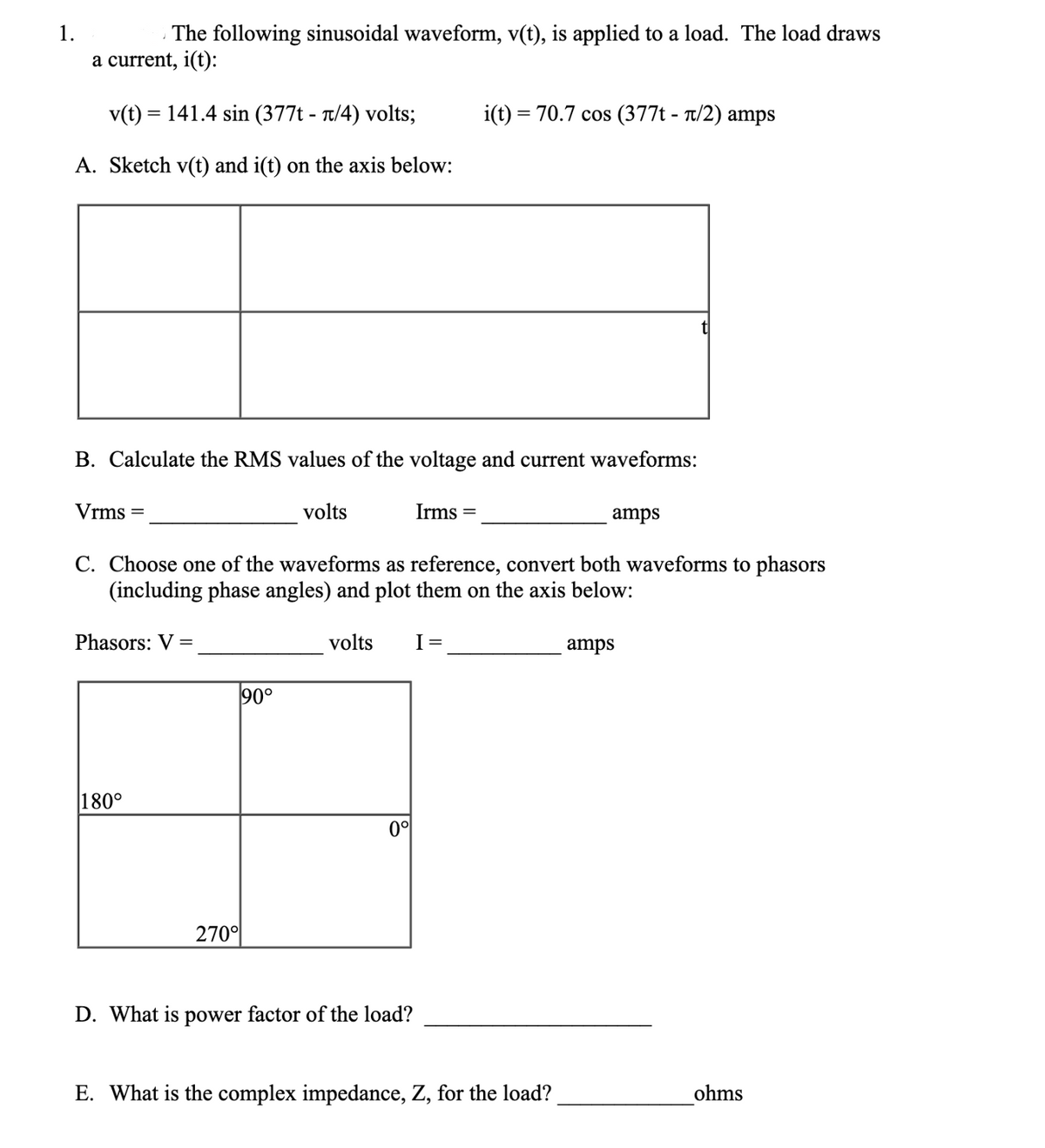1. The following sinusoidal waveform, v(t), is applied to a load. The load draws a current, i(t): v(t) = 141.4 sin (377t - π/4) volts; A. Sketch v(t) and i(t) on the axis below: B. Calculate the RMS values of the voltage and current waveforms: Vrms = 180° 90° volts 270⁰ C. Choose one of the waveforms as reference, convert both waveforms to phasors (including phase angles) and plot them on the axis below: Phasors: V = volts 0° Irms= D. What is power factor of the load? i(t) = 70.7 cos (377t - π/2) amps I= amps E. What is the complex impedance, Z, for the load? amps ohms
1. The following sinusoidal waveform, v(t), is applied to a load. The load draws a current, i(t): v(t) = 141.4 sin (377t - π/4) volts; A. Sketch v(t) and i(t) on the axis below: B. Calculate the RMS values of the voltage and current waveforms: Vrms = 180° 90° volts 270⁰ C. Choose one of the waveforms as reference, convert both waveforms to phasors (including phase angles) and plot them on the axis below: Phasors: V = volts 0° Irms= D. What is power factor of the load? i(t) = 70.7 cos (377t - π/2) amps I= amps E. What is the complex impedance, Z, for the load? amps ohms
Power System Analysis and Design (MindTap Course List)
6th Edition
ISBN:9781305632134
Author:J. Duncan Glover, Thomas Overbye, Mulukutla S. Sarma
Publisher:J. Duncan Glover, Thomas Overbye, Mulukutla S. Sarma
Chapter2: Fundamentals
Section: Chapter Questions
Problem 2.2MCQ: If the rms phasor of a voltage is given by V=12060 volts, then the corresponding v(t) is given by...
Related questions
Question
Q.

Transcribed Image Text:1.
The following sinusoidal waveform, v(t), is applied to a load. The load draws
a current, i(t):
v(t) = 141.4 sin (377t - π/4) volts;
A. Sketch v(t) and i(t) on the axis below:
B. Calculate the RMS values of the voltage and current waveforms:
Vrms
Phasors: V =
180°
90°
volts
C. Choose one of the waveforms as reference, convert both waveforms to phasors
(including phase angles) and plot them on the axis below:
volts
270⁰
Irms=
0°
i(t) = 70.7 cos (377t - π/2) amps
I =
D. What is power factor of the load?
amps
E. What is the complex impedance, Z, for the load?
amps
ohms
Expert Solution
This question has been solved!
Explore an expertly crafted, step-by-step solution for a thorough understanding of key concepts.
This is a popular solution!
Trending now
This is a popular solution!
Step by step
Solved in 5 steps with 2 images

Knowledge Booster
Learn more about
Need a deep-dive on the concept behind this application? Look no further. Learn more about this topic, electrical-engineering and related others by exploring similar questions and additional content below.Recommended textbooks for you

Power System Analysis and Design (MindTap Course …
Electrical Engineering
ISBN:
9781305632134
Author:
J. Duncan Glover, Thomas Overbye, Mulukutla S. Sarma
Publisher:
Cengage Learning

Power System Analysis and Design (MindTap Course …
Electrical Engineering
ISBN:
9781305632134
Author:
J. Duncan Glover, Thomas Overbye, Mulukutla S. Sarma
Publisher:
Cengage Learning